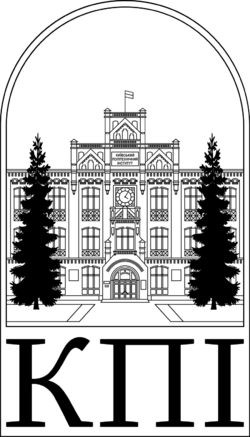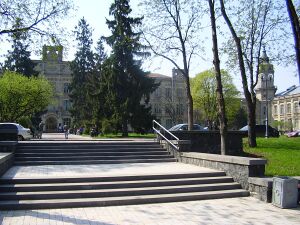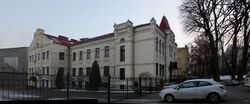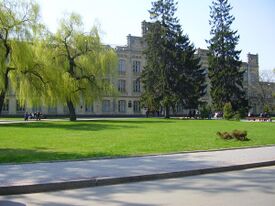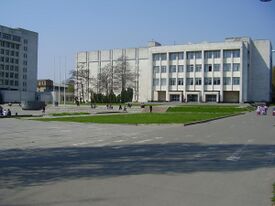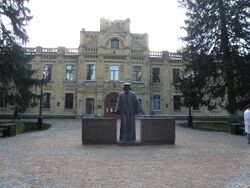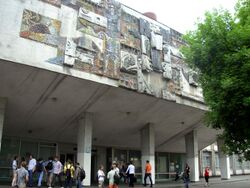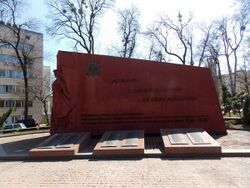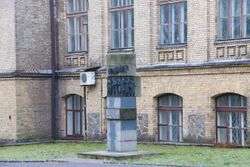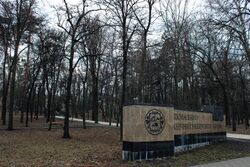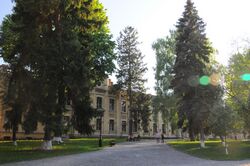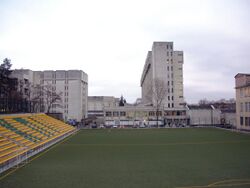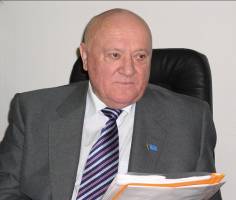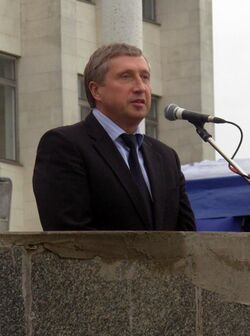Organization:Igor Sikorsky Kyiv Polytechnic Institute
(Ukrainian: Національний технічний університет України «Київський політехнічний інститут імені Ігоря Сікорського») | |
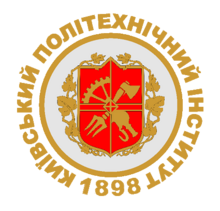 Seal of the Kyiv Polytechnic Institute | |
| Type | National university |
|---|---|
| Established | 1898 |
| Rector | Mykhailo Zghurovskyi |
Administrative staff | 2500 |
| Students | 36000 (approximately) |
| Location | , |
| Campus | 395 acres (1.60 km2) |
| Website | http://kpi.ua/ |
The National Technical University of Ukraine "Igor Sikorsky Kyiv Polytechnic Institute"[1] (NTUU "KPI") is a major university in Kiev, Ukraine . In January 2012 Webometrics Ranking KPI made it into top 1,000 – taking 957th place out of 20,300 universities, 510th (February 2013).[2]
Name
- 1898–1918 Kiev Polytechnic Institute of Emperor Alexander II;
- 1918–1927 Kiev Polytechnic Institute;
- 1934–1948 Kiev Industrial Institute; (during 1941–1944 evacuated to Tashkent)
- 1948–1968 Order of Lenin Kiev Polytechnic Institute;
- 1968–1992 Order of Lenin Kiev Polytechnic Institute in memory of the 50th anniversary of the Great October Socialist Revolution;
- 1992–1995 Kyiv Polytechnic Institute;
- 1995–2016 National Technical University of Ukraine "Kyiv Polytechnic Institute";
- 2016— National Technical University of Ukraine "Igor Sikorsky Kyiv Polytechnic Institute".
History
The institute was founded on 31 August 1898 as the Kiev Polytechnic Institute of Emperor Alexander II, but its current building complex was not built until 1902. Until then, the institute was renting out its space at the building of Commercial School located on Vorovsky Street. At that time it had four departments: Mechanical, Chemical, Agricultural, and Civil Engineering. The first enrolment constituted 360 students. The leading Russian scientists Dmitri Mendeleev, Nikolai Zhukovsky and Kliment Arkadyevich Timiryazev gave substantial scientific and organizational assistance in the founding of the institute.
Viktor Kyrpychov was the first rector of the KPI. It was largely due to Kyrpychov's efforts that such professors like V.P. Yermakov, S.M. Reformatsky, M.I. Konovalov or Vladimir Zworykin became members of the first faculty.
Since its establishing the institute was involved in the 1899 All-Russian student strike, which resulted in arrest and exile of 32 students. In the beginning of 1899 in the institute was established underground organizational committee and had a close relation with the Kiev council of united communities and organizations.
In 1930, the Kyiv National University of Construction and Architecture (KNUCA) was established on the basis of factory and communal construction branch of the Kyiv Polytechnic Institute (KPI) and the Architectural faculty of the Kyiv Art Institute.
Organisation
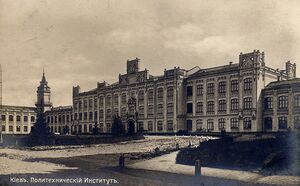
Institutes
- Educational and Scientific Complex "Institute of Applied Systems Analysis" - ESC "IASA" (connected with EPAM Systems, SAP AG, and SAS Institute)
- Educational and Research Institute of Telecommunication Systems - ITS
- Institute of Energy Saving and Energy Management - IEE
- Institute of Special Communication and Information Security - ISIS
- Mechanics and Machine-Building Institute - MMI
- Publishing and Printing Institute - VPI
- Physics and Engineering Institute - PTI (connected with Sun Microsystems and IBM)
- Inter-branch Institute of Post-graduate Education
- Institute of Pre-admission education and Vocational Guidance
Departments
- Aviation and Space
- Applied Mathematics[3] (connected with Freescale)
- Biotechnology and Biomedical Engineering[4]
- Chemical Engineering
- Electricity and Energy Engineering
- Electronics
- Engineering & Chemistry
- Engineering & Physics
- Heat-and-power Engineering (connected with EPAM Systems)
- Informatics and Computer Engineering[5] (connected with Cisco Systems)
- Instrument-Making
- Inter-university Medical Engineering Faculty (IMEF)
- Law
- Linguistics
- Management and Marketing
- Radioengineering
- Physical Training and Sports
- Physics and Mathematics
- Sociology
- Welding[6]
Facilities
The university has two campuses the central one being located in Kiev, and the other in town of Slavutych.
The Kiev campus of the university is located near the city centre in a park named after the university.
Here almost 9,000 of non-Kievite students are accommodated in 21 dormitories, 3 of them for married students. The life conditions at the university domes is a matter of numerous complaints of their inhabitants usually living in an 18 square meters rooms by 4 people in the room.
The institute has an outpatient medical department for employers and students.

The Institute also considers organized leisure a very important factor in bringing up young specialists.
The Knowledge Square is the centre of the entire KPI complex, measuring approx. 105 x 100 meters. The Knowledge square is connected to one of the main city thoroughfare, prospect "Peremohy". Meetings, festivals, and graduation ceremonies take place at the square.
The University also has an assembly hall with 1,750 seats. It was opened in August 1984.
Various sport facilities also exist at the institute. There are training grounds, soccer fields, volleyball and basketball courts at student disposal. There are many nationally rated athletes among the students of this institute.
Some Institutes were organized on the KPI basis. Among them are: the Civil Engineering Institute. Technological Institute of Light and Food Industry, the Institute of civil Aviation, Automobile and Road Building Institute, Agricultural (now Agricultural Academy) and others. In 1934 - 1944 the KPI was called an Industrial Institute.
Other Labs & Organisations
- Scientific Society of Students and Post-graduates
- Scientific-industrial laboratory DIDAKTIK
- UNESCO Chair in Higher Technical Education, Applied System Analysis and Informatics
- State Polytechnic Museum
- University Interclub
- University Library
Summer School
The Summer School “Achievements and Applications of Contemporary Informatics, Mathematics and Physics” (Summer School AACIMP) (Ukrainian: Літня Школа “Досягнення та застосування сучасної інформатики, математики та фізики”; Russian: Летняя Школа “Достижения и приложения современной информатики, математики и физики”) - is an annual international scientific-educational project of volunteers from the university's Student Science Association [7] of National Technical University of Ukraine “Kyiv Polytechnic Institute”.[8] It is aimed at an international audience of advanced students, postgraduates and young scientists. There are usually about 100 participants.[9]
It has been traditionally held each August since 2006. As a rule, the duration of the project is two weeks.
Science and education community
Student life
At present the number of students at the KPI more than 36,000. Approximately 400 of them are international students. In this way students, especially those who live in a hostel, have a social life with their foreign fellow students and a chance to learn more about other cultures, people and ideas. Over 4,500 students graduate from the KPI every year. The diploma is accepted by the European Union. The KPI has a preparatory department for foreigners. There is a possibility to study English and at the same time learn Ukrainian.
Full-time students attend the school for 5 years and 6 months; part-time - 5 years and 10 months.
The school offers 68 majors and 70 minors at its 3 branches. There are 16 departments and a college, including the following:
- Department of Informatics and Computer Engineering that offer courses on Electron Instrument Engineering, Cybernetics, and Control engineering and Computer engineering, among others.
- Electric Power Engineering Automation dept that offers courses Electrical Networks and Electric Systems, Central Power Plants, High Voltage Technique, and Cybernetics of Electrical Systems.
- Electro-Acoustic Faculty offering courses in Hydroacoustics Sound Recording, Measuring Techniques, and Microprocessors.
- Faculty of Radioengineering
- Physical engineering Department offering courses on Metallurgy, Metals and Alloys, Powder Metallurgy, and others.
Faculty staff and Academician community
There are 70% of the KPI teachers who have scientific degrees. Among them there are Academicians and Corresponding Members of the Ukrainian Academy of Sciences, Professors, and Merited Scientists. The language of instruction is predominantly Ukrainian, with options of Russian and English also available.
Number of the university's rectors served as ministers of education including the current rector Mykhailo Zghurovskyi.
The UNESCO CEPES (European Centre for Higher Education) ranked Kyiv Polytechnic Institute as the best university in Ukraine.[10]
Notable alumni
A large number of prominent people worked and studied at the KPI: E.O.Paton, the inventor of electric welding; M. I. Konovalov, a well-known chemist; I. P. Bardin, Ukraine's greatest metallurgist; A. M. Lyulka, USSR's premier designer of jet engines; rocket scientist Sergey Korolyov; creator of Sikorsky Helicopters, the well-known inventor Igor Sikorsky, well-known scientist in the field of fuel combustion and protection of the atmosphere from industrial pollution Isaak Sigal; Boris Yakovlevich Bukreev, a prominent mathematician known for his works in complex functions, differential equations, and non-Euclidean geometry. President of the First Exam Board in chemistry faculty was Dmitri Mendeleev.
Also must be mentioned: Stephen Timoshenko, reputed to be the father of modern engineering mechanics; Vladimir Chelomei, Soviet mechanics scientist and rocket engineer; Aleksandr Mikulin, Soviet aircraft engine designer and chief designer in the Mikulin OKB, Oleg Tozoni, the head of the Department of Electrodynamics at the Cybernetics Institute of the Academy of Science.
Chairman of the National Bank of Ukraine Valeriya Hontaryeva is also an alumna.[11][12]
Other institutes created based on KPI
- Kyiv National University of Construction and Architecture
- Kyiv National University of Technologies and Design
- Paton Institute of Electric Welding (National Academy of Sciences of Ukraine)
Recreation at KPI
The university has a well developed infrastructure of recreation and leisure, including sports, entertainment, arts, and others.
The university has a sports complex with an indoor swimming pool, a multi-hall building, and a soccer field.
The Kyiv Polytechnic Institute has been an important center of sports life in the city. Its football team "Politechniki" was one of the first football teams existed in the Russian Empire in 1906-1917.[13]
The university has several recreational resorts throughout a country. Two resorts are located near Kyiv, one is located in Carpathian Mountains, and another near Black Sea.[14]
The university has own arts center located in Center of Culture and Arts, better known by its Soviet standard name "Palace of Culture".[15][16] The concert hall of KPI Center Culture and Arts is the main venue of the Ukrainian national qualification for continental song contest Eurovision.
There is park on the territory of the university.
International relations
The Kyiv Polytechnic Institute has foreign economic relations with 45 foreign partners from 12 countries of the world. 29 agreements and 17 contracts have been concluded and 77 protocols have been signed: KPI received the certificate as a participant of foreign economic relations.
The most active international scientific and technological cooperation is carried out by the chairs of the institute with the partners from Poland , Germany, Bulgaria, Denmark and Lebanon. Lately the relations with China, United States, Italy, Vietnam and Spain have become more active. The institute carries out the exchange of students according to the agreement on cooperation with the University of Oregon (United States).
KPI was the first university of Ukraine that joined the community of the European Universities, and signed the visionary "Magna Charta of the European Universities" (“Magna Charta Universitatum”) in September 2003.
Friendly schools
Selected Co-operations
- Otto von Guericke University of Magdeburg (Germany)
- University of Klagenfurt (Austria)
- University of Miskolc (Hungary)
- University of Antwerp (Belgium)
- Iowa State University (USA)
- University of Manchester (Great Britain)
- Anhui University of Technology (China)
- University of Oregon (USA)
- University of Wisconsin-Madison (USA)
Rectors
First rectors of KPI were Russians, but after the 1905 Shuliavka Uprising (part of the 1905 Russian Revolution) there were Ukrainians. Soon after succession of Ukraine from the Soviet Union, the university rectors served as ministers at the Ministry of Education and Science of Ukraine.
- 1898 — 1902 Viktor Kirpichov
- 1902 — 1904 Mikhail Konovalov
- 1904 — 1905 Konstantin Zvorykin
- 1905 — 1906 Mykola Chyrvynskyi (first Ukrainian rector)
- 1906 — 1908 Volodymyr Tymofeyev
- 1908 — 1911 Konstantin Dementiev
- 1911 — 1917 Ivan Zhukov
- 1917 — 1919 Petro Yerchenko
- 1919 — 1920 George De Metz
- 1920 — 1921 Serhiy Veselovskyi
- 1921 — 1921 Ivan Kukharenko
- 1921 — 1929 Viktorin Bobrov
- 1929 — 1930 Dmitriy Melnikov
- 1930 — 1934 unknown
- 1934 — 1936 Mykola Yefimov
- 1936 — 1937 Pavlo Zhykharev
- 1937 — 1941 Mykola Shpylko
- 1941 — 1942 Mykola Velychkivskyi (in occupation)
- 1942 — 1944 unknown
- 1944 — 1952 Oleksandr Plyhunov
- 1952 — 1955 Vitaliy Gridnyev
- 1955 — 1955 Ivan Shvets
- 1955 — 1971 Oleksandr Plyhunov
- 1971 — 1987 Hryhoriy Denysenko
- 1987 — 1992 Petro Talanchuk
- 1992 — present Mykhailo Zghurovsky
Honours
- Until 1918 the university was honored with the name of Russian emperor Alexander II of Russia.
- After the World War II during the Soviet times the university was honored with the Order of Lenin and later with the 50th Anniversary of the Great October Socialist Revolution.
- In Ukraine it received honors of national and since 2016 carries the name of Igor Sikorsky as a former alumnus.
Rating
National Technical University of Ukraine “Kyiv Polytechnic Institute” positions in national and international ratings of the best Ukrainian educational institutions, employers ratings, etc.
- Ukrainian university academic rating «TOP – 200 Ukraine» - 1st place. (http://www.euroosvita.net)
- Ukrainian employers rating «Compass» - 1st place. (http://www.yourcompass.org)
- World universities ranking “Webometrics” – 713rd place (2012), 510th (2013) (http://www.webometrics.info)
- QS World University Ranking – 701+ (http://www.topuniversities.com)
Scientific journals
- International scientific journal "Radioelectronics and Communications Systems" (English version), "Izvestiya Vysshikh Uchebnykh Zavedenii. Radioelektronika" (Russian version)
- International scientific journal "System Research and Information Technologies"
- "Naukovi visti NTUU КPI"
- "Visnyk NTUU KPІ : Informatics, operation and computer science"
References
- ↑ "Archived copy". Archived from the original on February 12, 2011. https://www.webcitation.org/5wQnKXEPN?url=http://inter.kpi.ua/. Retrieved 2014-01-27. See official English page
- ↑ http://www.webometrics.info/top500_europe.asp?offset=400
- ↑ Інформаційний портал Факультету Прикладної Математики НТУУ "КПІ"
- ↑ Факультет біотехнології і біотехніки НТУУ "КПІ" Офіційний сайт
- ↑ ФІОТ | Національний технічний університет України
- ↑ Зварювальний факультет НТУУ "КПІ" Офіційний сайт
- ↑ Summer School page on Student Science Association web-page
- ↑ National Technical University of Ukraine page
- ↑ The article about the Summer School AACIMP in IFORS-2010
- ↑ "Best university in Ukraine". MIGnews.com.ua. http://mignews.com.ua/en/articles/29051.html.
- ↑ Ukraine crisis: EU deal to be signed on 27 June, BBC News (19 June 2014)
- ↑ (in Ukrainian) Top 10 facts about the new Governor NBU - Valeriya Hontaryeva, Телеканал новин 24 (19 June 2014)
- ↑ Politechniki Kyiv. Ukrsoccerhistory.
- ↑ List of KPI recreational resorts at relax.kpi.ua.
- ↑ KPI Palace of Culture (Палац культури КПІ) at Concert.ua
- ↑ Official website. KPI Center of Culture and Arts.
External links
- Kyiv Polytechnic Institute
- Kyiv Polytechnic Institute in Ukrainian
- Ukrayna Ulusal Teknik Üniversitesi Kiev Politeknik Enstitüsü
- KPI history (Історія КПІ). Kyiv Polytechnic Institute
- Blog KPI
- Student Council Campus in Kyiv Polytechnic Institute in Ukrainian
- Campus Map
[ ⚑ ] 50°26′59″N 30°27′39″E / 50.44972°N 30.46083°E
